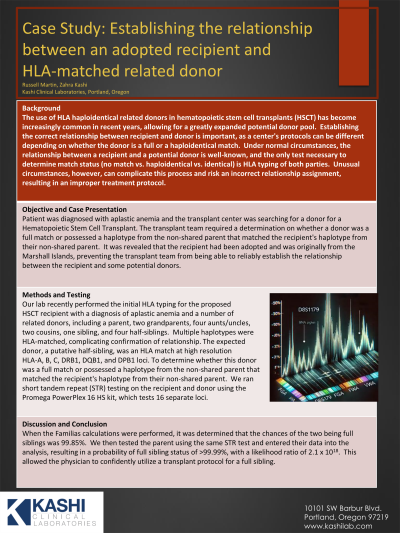Back

(P202) Establishing the relationship between an adopted recipient and their HLA-matched related donor
Location: Platinum Ballroom

Poster Presenter(s)
Body: The use of HLA haploidentical related donors in hematopoietic stem cell transplants (HSCT) has become increasingly common in recent years, allowing for a greatly expanded potential donor pool. Establishing the correct relationship between recipient and donor is important, as a center's protocols can be different depending on whether the donor is a full or a haploidentical match. Under normal circumstances, the relationship between a recipient and a potential donor is well-known, and the only test necessary to determine match status (no match vs. haploidentical vs. identical) is HLA typing of both parties. Unusual circumstances, however, can complicate this process and risk an incorrect relationship assignment, resulting in an improper treatment protocol.
Our lab recently performed the HLA typing for a proposed HSCT recipient with a diagnosis of aplastic anemia and a number of related donors, including a parent, two grandparents, four aunts/uncles, two cousins, one sibling, and four half-siblings. Multiple haplotypes were HLA-matched, complicating confirmation of relationship. The expected donor, a putative half-sibling, was an HLA match at high resolution HLA-A, B, C, DRB1, DQB1, and DPB1 loci. The transplant team asked us to determine whether this donor was a full match or possessed a haplotype from the non-shared parent that matched the recipient's haplotype from their non-shared parent. It was revealed that the recipient had been adopted and was originally from the Marshall Islands, preventing the transplant team from being able to reliably establish the relationship between the recipient and some potential donors. We ran short tandem repeat (STR) testing on the recipient and donor using the Promega PowerPlex 16 HS kit, which tests 16 separate loci. When the Familias calculations were performed, it was determined that the chances of the two being full siblings was 99.85%. We then tested the parent using the same STR test and entered their data into the analysis, resulting in a probability of full sibling status of >99.99%, with a likelihood ratio of 2.1E+18.
Conclusion: This result allowed the physician to confidently utilize a transplant protocol for a full sibling.
Our lab recently performed the HLA typing for a proposed HSCT recipient with a diagnosis of aplastic anemia and a number of related donors, including a parent, two grandparents, four aunts/uncles, two cousins, one sibling, and four half-siblings. Multiple haplotypes were HLA-matched, complicating confirmation of relationship. The expected donor, a putative half-sibling, was an HLA match at high resolution HLA-A, B, C, DRB1, DQB1, and DPB1 loci. The transplant team asked us to determine whether this donor was a full match or possessed a haplotype from the non-shared parent that matched the recipient's haplotype from their non-shared parent. It was revealed that the recipient had been adopted and was originally from the Marshall Islands, preventing the transplant team from being able to reliably establish the relationship between the recipient and some potential donors. We ran short tandem repeat (STR) testing on the recipient and donor using the Promega PowerPlex 16 HS kit, which tests 16 separate loci. When the Familias calculations were performed, it was determined that the chances of the two being full siblings was 99.85%. We then tested the parent using the same STR test and entered their data into the analysis, resulting in a probability of full sibling status of >99.99%, with a likelihood ratio of 2.1E+18.
Conclusion: This result allowed the physician to confidently utilize a transplant protocol for a full sibling.

